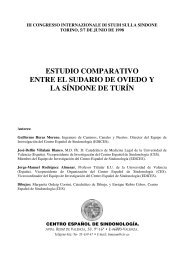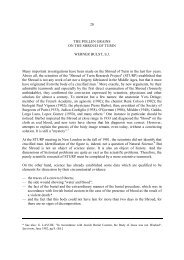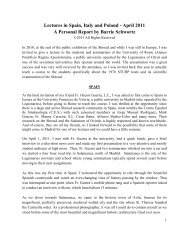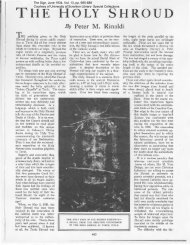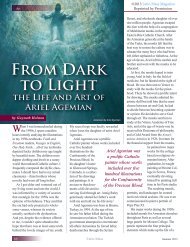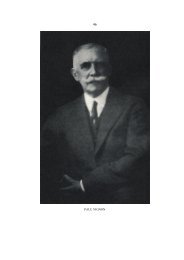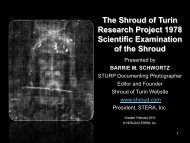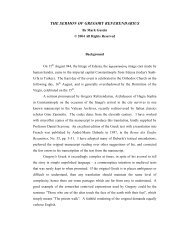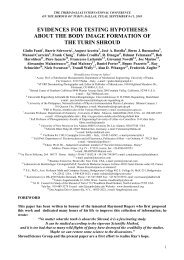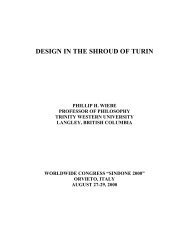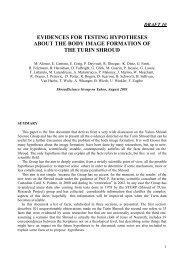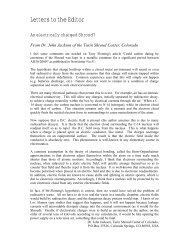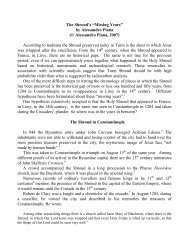THE LANGUAGE AND SENSIBILITY OF ... - Shroud of Turin
THE LANGUAGE AND SENSIBILITY OF ... - Shroud of Turin
THE LANGUAGE AND SENSIBILITY OF ... - Shroud of Turin
Create successful ePaper yourself
Turn your PDF publications into a flip-book with our unique Google optimized e-Paper software.
4. the loss <strong>of</strong> identity <strong>of</strong> Jesus,5. the depersonalization <strong>of</strong> Jesus,6. the use <strong>of</strong> euphemisms for the name <strong>of</strong> Jesus,7, the dehumanization <strong>of</strong> Jesus,8. a disturbing sensibility.My analysis <strong>of</strong> the research papers will discuss the above points.(i) The Significance <strong>of</strong> the Religious RelicMy first argument relates to the fact that the Holy <strong>Shroud</strong> is a religiousrelic.William Meacham in a thoughtful paper ‘An Authentication <strong>of</strong>the <strong>Turin</strong> <strong>Shroud</strong>: An issue in Archaeological Epistemology’ (6) states,“The fact that it is a religious relic associated with supernaturalclaims is <strong>of</strong> no consequence here; certainly there is nojustification for employing different or stricter criteria than forany other important artefact, except perhaps in accordinggreater consideration to the possibility <strong>of</strong> forgery.” (myemphasis) (7)I disagree. Not with the proposal <strong>of</strong> uniform standards and criteria for allresearch, - which is the reason for my paper - but with the basis <strong>of</strong> Meacham’sargument that the classification <strong>of</strong> the Holy <strong>Shroud</strong> as a religious relic is <strong>of</strong> “noconsequence”. How can it be <strong>of</strong> no consequence that these are religious relics? It is <strong>of</strong>no small consequence that these Holy <strong>Shroud</strong>s are believed to be the relics <strong>of</strong> JesusChrist. That is why there is so much interest in the Holy <strong>Shroud</strong>s.Meacham’s error is to refer to the Holy <strong>Shroud</strong> as both a ‘religious relic’ andan ‘artefact’. This is a contradiction in terms. An artefact belongs to archaeology, arelic belongs to religion.The fact that the Holy <strong>Shroud</strong> is a religious relic demands some considerationfrom all researchers, believers and non-believers in its authenticity, both Christian andnon-Christian. Consideration should at least be perceived in the sensibility that informsthe writing <strong>of</strong> research papers. Yes, the standards and criteria used when conductingresearch into the Holy <strong>Shroud</strong>s should be as stringent as for other research; so tooshould the writing <strong>of</strong> the research papers. Researchers should keep in mind that theHoly <strong>Shroud</strong>s are religious relics for Christians. One’s disbelief should not empowerone to scorn another’s religious beliefs.Proposal 2:Research papers should reflect the awareness that the Holy <strong>Shroud</strong> <strong>of</strong> <strong>Turin</strong> and theHoly Sudarium <strong>of</strong> Oviedo are believed to be the relics <strong>of</strong> Jesus Christ.(ii) The Universal Uniqueness <strong>of</strong> Jesus ChristMy second argument is based on ‘Universal Uniqueness’. Where there is oneperson <strong>of</strong> a type, a person who is unique in the universe, our language permits us to4
when writing about a religious relic <strong>of</strong> whatever denomination, would certainly comewithin the scope <strong>of</strong> meeting academic standards.I will therefore, go even further than William Meacham. I propose thatresearch papers on the Holy <strong>Shroud</strong>s should not written in a style that causes <strong>of</strong>fenceto the reader.(iv) The Loss <strong>of</strong> Identity <strong>of</strong> Jesus ChristMy fourth argument relates to Jesus Christ’s loss <strong>of</strong> identity in research papers.Robert Bucklin in his paper titled “An Autopsy on the Man <strong>of</strong> the <strong>Shroud</strong>”, (10)proceeds in the same manner that he would if he were conducting an autopsy on acorpse: he determines the cause <strong>of</strong> death, then the identity <strong>of</strong> the deceased person. Forthe length <strong>of</strong> the paper Bucklin proceeds as if he does not know the identity <strong>of</strong> thecorpse he is performing the ‘autopsy’ on, and the reader - believer and non-believer inthe Holy <strong>Shroud</strong>’s authenticity - goes along with him. Finally Bucklin states:“It is the ultimate responsibility <strong>of</strong> the medical examiner to confirmby whatever means are available to him the identity <strong>of</strong> the deceased,as well as to determine the manner <strong>of</strong> this death. In the case <strong>of</strong> theMan <strong>of</strong> the <strong>Shroud</strong>, the forensic pathologist will have informationrelative to the circumstances <strong>of</strong> death by crucifixion which he cansupport by his anatomic findings. He will be aware that theindividual whose image is depicted on the cloth has undergonepuncture injuries to his wrists, and feet, puncture injuries to his head,multiple traumatic whip-like injuries to his back and postmortempuncture injury to his chest area which has released both blood and awater type <strong>of</strong> fluid. From this data, it is not an unreasonableconclusion for the forensic pathologist to determine that only oneperson historically has undergone this sequence <strong>of</strong> events. Thatperson is Jesus Christ.” (11)Bucklin has identified the corpse. Having reached this conclusion following the socalled‘autopsy’, the reader has a legitimate expectation that references to the ‘Man <strong>of</strong>the <strong>Shroud</strong>’ will be substituted with the name <strong>of</strong> the person identified by the‘autopsy’, viz. Jesus Christ. Bucklin, however, reverts to his former style. He avoidsthe use <strong>of</strong> the name ‘Jesus Christ’. Bucklin substitutes “decedent” and “the individual”for the name <strong>of</strong> Jesus.“For the manner <strong>of</strong> death to be determined, a full investigation <strong>of</strong> thecircumstances <strong>of</strong> death is necessary. In this case it would bedetermined historically, that the individual was sentenced to death,and that the execution was carried out by crucifixion. The manner <strong>of</strong>death would be classed as judicial homicide.”(12)This is interpreted as a loss <strong>of</strong> identity. The unknown, nameless ‘Man <strong>of</strong> the<strong>Shroud</strong>’ has been identified as Jesus Christ for the purpose <strong>of</strong> Bucklin’s paper, but inthe final analysis, there is a reluctance to attribute a name to the ‘Man <strong>of</strong> the <strong>Shroud</strong>’.In the above paragraph, Bucklin could have written, ‘In this case it would bedetermined historically that Jesus Christ was sentenced to death’ .....6
(v) The Depersonalization <strong>of</strong> Jesus ChristMy fifth argument relates to the absence <strong>of</strong> a referent or an agent in researchpapers. Frederick T Zugibe in his paper “Pierre Barbet Revisited”, writes about the‘Cause <strong>of</strong> Death’ (13) as follows:“In order to arrive at the most probable cause <strong>of</strong> death, it isnecessary to examine the sequence <strong>of</strong> all the events fromGethsemane through Calvary, the severe mental anguish exhibited inthe Garden <strong>of</strong> Gethsemane would cause some loss in blood volumeboth from sweating and hematodrosis and provoke markedweakness.” (14)This is a passive clause because there is no referent to experience the mentalanguish, the loss <strong>of</strong> blood, even the death. Zugibe in the paragraph the ‘cause <strong>of</strong>death’ refers to no-one. The ‘events from Gethsemane through Calvary’ relates to noone.The mental anguish is ‘exhibited’ by no-one. These experiences could relate tothe disciples, to Judas, to the Roman soldiers, to Jesus Christ. We are not told towhom they relate. Why is no-one experiencing Gethsemane to Calvary? Or the agonyin the Garden?Whereas there was no person as a referent in the above sentence, Zugibe thenuses the term ‘victim’. The victim not having been identified as male or female,Zugibe then introduces ‘he’ into the paragraph. There is no antecedent for ‘he’ exceptthe ‘victim’, who was neither male nor female. The name <strong>of</strong> Jesus Christ has notappeared. Yet Zugibe provides the reader with the names <strong>of</strong> Temney and Primrose,and gives both the common and botanical names for the thorns which went intomaking the crown <strong>of</strong> thorns on Jesus’ head.What is the effect <strong>of</strong> writing in this manner? Where the pain, the suffering, theanguish, the cause <strong>of</strong> death, become subjects <strong>of</strong> the sentence? Writing that replacesthe actual subject <strong>of</strong> the sentence who should be the person experiencing the pain andsuffering? Where the acts committed against a person, and the experiences that aperson lives through are communicated without that person being referred to?The effect is for the person to be distanced from the action and the experience.The person is removed from the acts and experiences. Such writing renders theexperiences less potent, less active, less dramatic, less meaningful, because it is notidentified with a person. In effect, the suffering experienced by Jesus Christ, isremoved from Him. Jesus Christ has been depersonalized in this type <strong>of</strong> writing.(vi) Euphemisms for the name <strong>of</strong> JesusMy sixth argument relates to the use <strong>of</strong> euphemisms by researchers whenreferring to Jesus Christ. A euphemism is a word substituted for another when the firstword would cause <strong>of</strong>fence. For example, instead <strong>of</strong> saying that a man is lying, onemight say ‘ he is being economical with the truth’. People use euphemisms whenwomen are present, in the presence <strong>of</strong> children, for parts <strong>of</strong> the body etc. Holy<strong>Shroud</strong> researchers use euphemisms for the name <strong>of</strong> Jesus Christ in their researchpapers. Euphemisms that appear in research papers are ‘Cruciarius’, ‘victim’, ‘the man<strong>of</strong> the shroud’, ‘the decedent’, ‘the individual’ ‘the crucified’, ‘the deceased’, ‘theindividual’ etc. The question one has to ask is, ‘What is <strong>of</strong>fensive about the name <strong>of</strong>7
Jesus Christ that would prompt researchers to use euphemisms for the name <strong>of</strong> Jesus?Surely nothing.It may be because researchers base their hypotheses and begin their papers onthe assumption that the identity <strong>of</strong> the Man whose image appears on the Holy <strong>Shroud</strong>is not known. If my first proposal is accepted, then the euphemisms for the name <strong>of</strong>Jesus Christ would become unnecessary.(vii) Dehumanizing the Passion <strong>of</strong> JesusMy seventh argument is the separation <strong>of</strong> the physical and physiologicalelements <strong>of</strong> Jesus’ body from Himself. The research papers utilize the impersonalpronoun ‘it’ when referring to the experiences <strong>of</strong> Jesus For example, ‘It bled’. Whatis ‘it’? ‘It’ refers to the wound, the head, the hand. Belonging to whom? Belongingto Jesus Christ. It should be ‘He bled’, or ‘His hand bled, or ‘His wounds bled’.‘It’ refers to a thing. It is mainly used in connection with inanimatereferents.’(5) If the argument for using ‘it’ when referring to Jesus suffering, is thatJesus was dead, my response is tw<strong>of</strong>old:1. Jesus was alive while His wounds bled.2. Christians believe that Jesus lives. He is the living God. Because the Holy<strong>Shroud</strong>s are Christian relics, research papers should respect that belief.There is no argument for using ‘it’ when referring to the suffering <strong>of</strong> JesusChrist.Researchers in their manner <strong>of</strong> writing, have dehumanized the suffering <strong>of</strong>Jesus Christ.(viii) The Sensibility <strong>of</strong> <strong>Shroud</strong> researchMy eight argument relates to the overall sense I have when reading the Holy<strong>Shroud</strong> research papers. In some the tone <strong>of</strong> writing is mocking, and derisory. Itgives one some awareness <strong>of</strong> the sensibility <strong>of</strong> the crowd and the Roman soldiers atthe time <strong>of</strong> the Passion <strong>of</strong> Christ. The research also includes work that is macabre andsado-masochistic. Frederick T Zugibe writes as follows:“The large square iron nails driven through both hands into the crosswould damage the sensory branches <strong>of</strong> the median nerve resulting inone <strong>of</strong> the most exquisite pains every experienced by people andknown medically as causalgia.”(14) (my emphasis)Zugibe is referring to the pain experienced when the Median nerve <strong>of</strong> an unnamedperson is struck with a nail. The reader will be cognizant <strong>of</strong> the fact that this is the painthat was suffered by Jesus Christ.Without meaning to <strong>of</strong>fend, I respectfully request Sindonology researchers,interest groups and individuals to be sensitive to the fact that Christians love JesusChrist.IV. <strong>LANGUAGE</strong> STYLE SHEET PROPOSALS:8
Research and academic institutions, and academic journals throughout theworld, stipulate the format and the style sheet for articles, research papers, doctoraltheses. For example the Modern Language Association <strong>of</strong> America has its own stylesheet which is used by many universities. Sindonology research papers should alsoconform to a style sheet because the research is <strong>of</strong> an academic nature, and becauseSindonology focuses on two Christian relics, the style sheet should conform to stylesheets adopted by Christians when writing about Jesus Christ. My source is The HolyBible: New King James Version. (57)I am proposing that Sindonology research papers should maintain the samehigh standards in the use <strong>of</strong> language as researchers would use for any other form <strong>of</strong>research, and as the editors and translators <strong>of</strong> the Holy Bible would use.Proposal 3:Research papers should conform to an academic style that does not cause<strong>of</strong>fence to believers in the authenticity <strong>of</strong> the Holy <strong>Shroud</strong> <strong>of</strong> <strong>Turin</strong> and the Holy<strong>Shroud</strong> <strong>of</strong> Oviedo as the relics <strong>of</strong> Jesus Christ.I propose the following language style sheet as a guideline for futureSindonology research papers. I sincerely hope that researchers and journals will notbe <strong>of</strong>fended by my proposals. I welcome additions, criticisms, and corrections.SINDONOLOGY <strong>LANGUAGE</strong> STYLE SHEET1) Research hypotheses should be formulated to prove that the Holy<strong>Shroud</strong>s are not the authentic relics <strong>of</strong> Jesus Christ, the basic assumptionbeing that these are believed to be the relics <strong>of</strong> Jesus Christ.2) The language <strong>of</strong> research papers should meet academic standards andshould not cause <strong>of</strong>fence.3) The <strong>Shroud</strong> <strong>of</strong> <strong>Turin</strong> and the Sudarium <strong>of</strong> Oviedo should be referred to as theHoly <strong>Shroud</strong> <strong>of</strong> <strong>Turin</strong> and the Holy Sudarium <strong>of</strong> Oviedo, using initial capitals.4) Both the Holy <strong>Shroud</strong> <strong>of</strong> <strong>Turin</strong> and the Holy Sudarium <strong>of</strong> Oviedo may bereferred to as the Holy <strong>Shroud</strong>s.5) While not seeking for reverence, the writing should refrain fromirreverence, ridicule, blasphemy.6) Euphemisms should not be used in place <strong>of</strong> the name <strong>of</strong> Jesus Christ.7) The article ‘the’ may be used to reflect the universal uniqueness <strong>of</strong> Jesus as in‘The Christ’, ‘The Messiah’, ‘The Saviour’, ‘The Lamb’.8) When referring to Jesus Christ, the writer should use personal pronouns e.g.His, Him, He.9) Personal Pronouns referring to Jesus Christ should use initial capitals i.e.You, Your, Yours, His, Him. He. (I am basing this point on the usage <strong>of</strong>the King James Bible)10) The physical and physiological parts <strong>of</strong> the Body <strong>of</strong> Jesus Christ shouldbe attributed to Jesus Christ by the use <strong>of</strong> the possessive pronoun andshould not be referred to as if they had an existence <strong>of</strong> their own. Theacceptable usage would be ‘His Wounds’, ‘His Blood’, ‘His Body’, ‘HisHands’, ‘His Feet’, ‘His Head’, etc.11) Parts <strong>of</strong> the Body <strong>of</strong> Jesus Christ such as the wounds, the blood, the body,9
should not be referred to with the impersonal pronoun ‘it’.12) References to the parts <strong>of</strong> the Body <strong>of</strong> Jesus Christ e.g. Body, Blood,Wrists, Hands, Feet, Wounds, should be indicated with an initial capital.13) Words attributed to Jesus Christ, such as words quoted from the HolyBible, should be marked <strong>of</strong>f from the rest <strong>of</strong> the text by the use <strong>of</strong> Italics,underlining, or colour. (The King James Bible demarcates the wordsspoken by Jesus in red ink).V. BIBLIOGRAPHY:[Editor's Note: This bibliography includes many references to Internet addresses. Toview these materials, simply highlight and copy the address and paste it into your webbrowser.]1. Third World Children Dreaming, Agnes Sam, Critical Quarterly Vol.37,No.3,19952. The Tyranny <strong>of</strong> Karma, Agnes Sam BBC Radio 4, London, 19943. Dora, Agnes Sam, BBC Radio 4, London, 19904. Jesus is Indian and other South African Stories, Agnes Sam, The Women’sPress, London, 1989; Heinemann Publishers, Oxford, 1994.5. What Passing Bells, Kunapipi, Dangaroo Press, University <strong>of</strong> Aarhus, 1988.6. An Authentication <strong>of</strong> the <strong>Turin</strong> <strong>Shroud</strong>: An issue in ArchaeologicalEpistemology , William Meacham, Archaeologist, Current Anthropology,Vol. 24, No. 3, June 1983. http://www.shroud.com/meacham.htm7. An Authentication <strong>of</strong> the <strong>Turin</strong> <strong>Shroud</strong>: An issue in ArchaeologicalEpistemology , William Meacham, Archaeologist, Current Anthropology,Vol. 24, No. 3, June 1983.(p2) http://www.shroud.com/meacham.htm8. The Bloody Icon , Emanuela Marinelli,http://www.shroud.com/collega7.htm9. The Satanic Verses, Salman Rushdie10. An Autopsy on the Man <strong>of</strong> the <strong>Shroud</strong>, Robert Bucklin M.D. J.D.,Las Vegas, Nevada, 1997. http://www.shroud.com/bucklin.htm11. An Autopsy on the Man <strong>of</strong> the <strong>Shroud</strong>, Robert Bucklin M.D. J.D.,Las Vegas, Nevada, 1997. http://www.shroud.com/bucklin.htm12. An Autopsy on the Man <strong>of</strong> the <strong>Shroud</strong>, Robert Bucklin M.D. J.D.,Las Vegas, Nevada, 1997. http://www.shroud.com/bucklin.htm13. An Autopsy on the Man <strong>of</strong> the <strong>Shroud</strong>, Robert Bucklin M.D. J.D.,Las Vegas, Nevada, 1997. http://www.shroud.com/bucklin.htm14 Pierre Barbet Revisited; Frederick T Zugibe MD Ph.D.,http://www.shroud.com/Zugibe.htm15. Pierre Barbet Revisited; Frederick T Zugibe MD Ph.D.,http://www.shroud.com/Zugibe.htm16. The Data and the Date: Emanuela Marinelli,http://www.shroud.com/colleg11.htm17. Debunking the <strong>Shroud</strong>: Made by Human Hands: Gary Vikan,http://www.shroud.com/bar.htm18. An Appraisal <strong>of</strong> the Mistakes Made Regarding the <strong>Shroud</strong> Samples Takenin 1988 - and a suggested way <strong>of</strong> putting these behind us. Ian Wilsonhttp://www.shroud.com/wilson.htm10
19. Radiocarbon Measurement and the Age <strong>of</strong> the <strong>Turin</strong> <strong>Shroud</strong>: Possibilitiesand Uncertainties.20. The Legal and Medical Aspects <strong>of</strong> the Trial and Death <strong>of</strong> Christ, RobertBucklin, M.D. J.D., http://www.shroud.com/bucklin.htm.21. The <strong>Shroud</strong> <strong>of</strong> <strong>Turin</strong>: A Parable for Modern Times? Thaddeus J Trenn,http://www.shroud.com/trenn.htm.22. In Front <strong>of</strong> the <strong>Shroud</strong>:Neither Iconoclasts Nor Fundamentalists, OrazioPetrosillo - Journalist, http://www.shroud.com/collega8.htm23. The Man <strong>of</strong> the <strong>Shroud</strong> was washed Frederick T. Zugibe M.D. Ph.D.http://www.shroud.com24. The <strong>Shroud</strong> <strong>of</strong> Turn: Bridge between Heaven and Earth? Joseph G.Marino and M Sue Bedford, R.N. M.A.25. It’s the Message that Matters, Russell A. Breault http://www.shroud.com26. The <strong>Shroud</strong> Chapel is Three Hundred Years Old Emanuela Marinelli,http://www.shroud.com/colleg5.htm27. Verification <strong>of</strong> the Nature and Cause <strong>of</strong> the Photo-negative Images on the<strong>Shroud</strong> <strong>of</strong> Lirey - Chambrey - <strong>Turin</strong>http://www.unisa.ac.za/dept/press/dearte/51/deartum.html28. Radiocarbon Dating <strong>of</strong> the <strong>Shroud</strong> <strong>of</strong> <strong>Turin</strong>, P.E. Damon et al,http://www.shroud.com/natur.htm29. The Concept <strong>of</strong> Negativity Through the Ages vs The Negative Image on the<strong>Shroud</strong>., Isabel Piczek, http://www.shroud.com/piczek3.htm.30. Dating and Formation <strong>of</strong> the <strong>Shroud</strong> , Peter Carr, March 1999,http://www.shroud.com31. The Fire and the Portrait, Jack Markwardthttp;//www.shroud.cm/markwar2.htm32. Alice in Wonderland and the <strong>Shroud</strong> <strong>of</strong> <strong>Turin</strong>, Isabel Piczekhttp://www.shroud.com/piczek2.htm33. Was the <strong>Shroud</strong> in Languedoc During the Missing Years? JackMarkwardt, http://www.shroud.com/markwardt.htm34. The Burial <strong>of</strong> Jesus: With Focus on the views <strong>of</strong> the Jesus Seminarhttp://www.members.xoom.com35. A Difficult Piecehttp://sindone.torino.chiesacattolica.it/en/scient/oggetto.htm36. The First <strong>Shroud</strong> Photo, Remi Van haelst, Belgium,http://www.shroud.com/vanhels4.htm37. The Sudarium <strong>of</strong> Oviedo: its history and relationship to the <strong>Shroud</strong> <strong>of</strong><strong>Turin</strong>, Mark Guscin, B.A. M.Phil.http://www.shroud.com/guscin.htm38. The Disciples on the Road to <strong>Turin</strong>, Reverend Joseph Marino, O.S.B.http://www.shroud.com/marino.htm39. Comforting the Mournershttp://www.shemayisrael.co.il/burial/mourning.htm40. FAQ Rituals:http://www.torahview.com/burial/html/rituals.html41. Results <strong>of</strong> a Probabilistic model applied to the research carried out on the<strong>Turin</strong> <strong>Shroud</strong>, Guilo Fanti, Emanuela Marinellihttp://www.shroud.com42. Brief History <strong>of</strong> the <strong>Shroud</strong>, Caesar Gili,11
http://www.imswebs.com/holy-shroud/shroud.htm43. Highlights <strong>of</strong> the Undisputed History, Ian Wilsonhttp://www.shroud.com/history.htm44. What does the <strong>Shroud</strong> <strong>of</strong> <strong>Turin</strong> Mean: Robert Penyhttp://www.shroud.com45. The Wounds <strong>of</strong> the Passion <strong>of</strong> Christhttp://sindone.torino.chiesacattolica.it/en/oslens/sf97053.htm46. The Holy <strong>Shroud</strong>http://www.di.unilo.it/sindon/story.htm47. The Donation <strong>of</strong> the <strong>Shroud</strong> to the Holy See , Luigi Fossati - Historianhttp://www.shroud.com/collega3.htm48. Friends <strong>of</strong> <strong>Shroud</strong>.comhttp://www.shroud.com/friends.htm49. The ‘98 Symposium: A Personal Report, Barrie M. Schwortzhttp://www.shroud.com/torinsy2.htm50. ‘Not-Made-By-Human-Hand’,http://home.fireplug.net/rshand/reflections/messiah/edessa.html51. The Image <strong>of</strong> Edessa: Earliest References to Christ’s Burial Cloths.http://home.fireplug.net/rshand/reflections/messiah/edessa.htm.52. Liturgical Clues to the <strong>Shroud</strong>’s History, Rev. Albert R. Dreisbach Jr.http://www.shroud.com/dreisbch.htm53. The Sudarium <strong>of</strong> Oviedohttp://www.shroud.com/bar.htm54. Chronology <strong>of</strong> the <strong>Shroud</strong>http://www.di.unito.itsindon/chrono.htm55. The Oxford Dictionary <strong>of</strong> English Grammar, Sylvia Chalker andEdmund Weiner, Oxford University Press, 199456. The <strong>Shroud</strong> <strong>of</strong> <strong>Turin</strong>, Ian Wilson, Doubleday & Co, New York, 1978.57. The Holy Bible: New King James Version, Thomas Nelson Inc. 1980 USA© Agnes Sam 1999email: agnes.sam@tiscali.co.uk12



